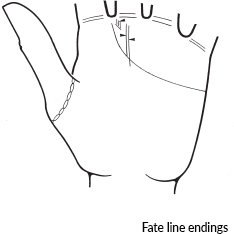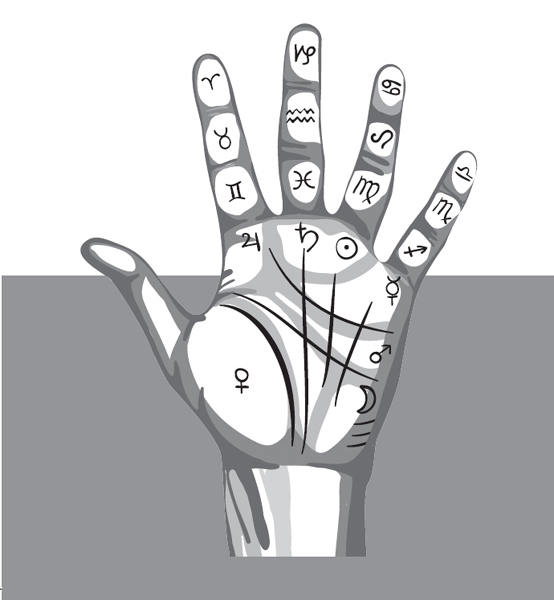
For centuries, palmists have enjoyed talking about lines on the hand and have given them names and characteristics. Lines are controlled by the nerve endings. They give a physical computer printout of the life and development of each one of us. The lines show our order of priorities and the value that we award ourselves and also our activities. They pick out the environmental influences upon us, add our reaction to those around us, and indicate the depth of the feelings we have toward our mate, family, and friends. They display our dedication to a career or job, as well as our ability to handle it.
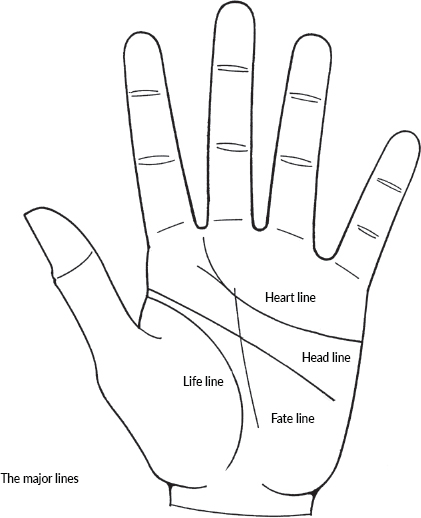
We have already talked about the mount of Venus, the area that is enclosed by the life line—but what about the life line itself? It can wrap around Venus or reach out toward the middle of the hand. It can be forked at the end with one branch wrapping around and the other reaching out or make any variety of other shapes. Let us consider these one by one.
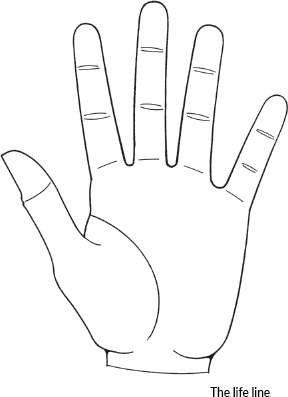
A long life line that bows out and forms a large mount of Venus indicates passion and a desire to live life to the full—but the downside is that this person likes his own way and he is inclined to have a bad temper. If the line is straighter and creates a smaller Venus mount, the individual is softer, less passionate and more even tempered. He spends more time thinking and dreaming than making things happen or putting much energy into making money. If the line rounds the base of the thumb, then home life and possessions are important. This person may strive to live close to his job or even at his place of work.
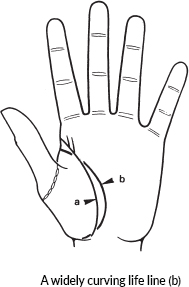
This person is keen on his home and family life. He is not particularly interested in travel or in making his mark on the world; although, this does rather depend upon the height of the mount of Venus, which is an indicator of whether he will put in the effort needed to make the money he needs. A woman with this kind of life line may be the earth mother type, growing her own vegetables and keeping animals as well as looking after the home and family.
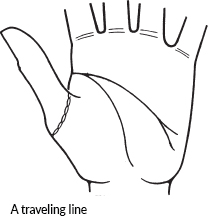
When the line travels out into the hand toward Luna, the person is work oriented and he may travel for business or pleasure. He will meet many people during the course of his work, which may be for the benefit of strangers or the public. He will also use his creativity, imagination and intuition as part of his job.
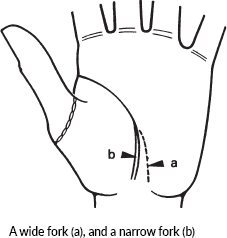
Most people have some kind of fork at the end of the life line—and that is when the line is in one piece in the first place. A fork indicates a combination of home life, career, travel and a variety of outside interests.
A narrow fork means that there is a long struggle to cope with two demands at once. A typical scenario is that of a woman who brings up children alone. This kind of fork is sometimes so long and narrow that it almost becomes a double life line.
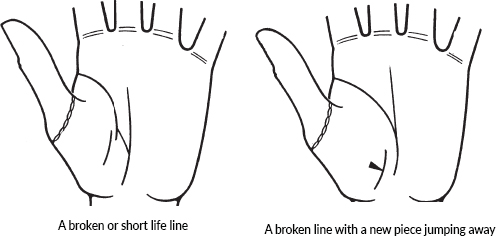
Short life lines are a common feature and some parts of them are frequently absorbed into part of the fate line. Alternatively, they stop and then start again further down the hand.
Check for trauma, divorce, redundancy, a change of country or some other major events. If a new piece of line appears lower down the hand, this shows that the subject's life is settling back down again, or that he gets back on his feet again. This can indicate recovery from a long illness or even recovery from alcoholism or drug addiction.
The life line can start high up on the hand, sometimes with a branch or two reaching up to the mount of Jupiter. This brings idealism and a cool, logical personality who is also a perfectionist. If it starts lower down, it suggests a more practical, sociable attitude but with powerful emotions allied to a bubbly personality.
If the start of the line is messy, the person's early life is difficult. Islands here can indicate early health problems or emotional traumas. (Check the base of the fate line for confirmation). A fine line that falls down from the life line in this area can denote the loss of a loved one—through divorce, death or some other circumstance—in childhood or youth.
A quick guide to timing of youthful events is to drop an imaginary line down from the middle of the Saturn finger (the middle finger) to the life line. The section of life line that precedes this point relates to around the first eighteen to twenty-one years of life.
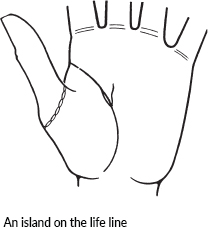
If you spot a break in a line, an island, a bar that cuts across it or any other disturbance, check out both hands because trauma will often show up more strongly on the minor hand than the major one. If such a mark is on both hands, the subject's life will change in practical as well as emotional terms, or there may be a health problem to overcome. A long narrow island shows a period of deliberate self-sacrifice. This may mean setting aside personal desires for the sake of educating children or working while a partner studies. It simply means that the person puts his own wishes on hold for a longish period. He is also likely to be short of money during this time.
Lines that rise up from the life line show self-motivation and effort. Note which mount these lines are leading to, as this will indicate what the person is striving to achieve. Lines that fall down show that the subject has given up on something. It can also suggest that a situation has run its course and ended. A rising line often follows an island. This suggests that the subject survives a time of struggle and then makes a successful effort to overcome his problems.
Palmists have different names for these lines—the line of Mars, the median line, sister lines, shadow lines and so on. Sometimes there are two well-defined lines behind the life line and some palmists call one the line of Mars and the other the median line. This gets so complicated that even I tend to call these shadow lines and leave it at that.
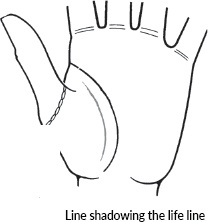
Shadow lines offer protection from illness and accidents, and people who have them are less inclined than others to fall sick or to catch viruses. These lines can also indicate spiritual protection, a spiritual pathway—or oddly, a life in the armed services.
Tiny pits on the life line tell us that something is wrong with the spine or its surrounding muscles, ligaments and tissues. Slipped discs and other such problems are a common cause. Pits close to the start of the line show that the neck is the problem area, and the problem moves down according to their position. Pits around the lower end of the line signify problems with the hips and legs and the lumbar or sacral areas of the spine.
The life line may end abruptly, it may form tassels or it may just fizzle out. An abrupt ending suggests that the person will be strong and fit right up to the end, while the other two scenarios signify failing health for some years before life ends. It is wise to check the top of the hands immediately beneath the fingers. Lines that reach up toward the fingers suggest that the person will have a long life. If there is nothing marked, it may be because the person is young and that these lines have yet to develop.
The head line is associated with the way a person's mind works, his aptitudes, education and career path and to some extent, financial matters. The head line starts on the thumb side of the hand and travels more or less across the palm. The position of the starting and ending points can vary enormously and still be normal. When the life line is weak but the head line is strong, the person can overcome weak health or other problems.
The head line starts from the thumb side of the hand and it may join the life line or it may be independent from it. It then runs across the hand horizontally or diagonally.
Old-time palmists claimed that a head line that is tied to the life line at the start means that the individual is slow to grow up and stand on his own two feet, while a wide gap means that he thinks for himself and is also independent in practical terms while relatively young. This doesn't seem to be born out by fact—in that the “tied” person sits at home until he is middle aged, while the “free” one leaves home while still young. However, what does seem to happen is that the “tied” person's parents dominate him, while the “free” one has an easy relationship with his family along with plenty of mutual respect.
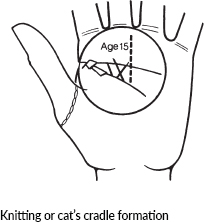
A muddled area that looks like pieces of knitting lying between the head and life line, at the point where they part suggests that the subject hated school. Alternatively, he loved it because it represented an escape from a repressive family or domestic difficulties.
A straight line that travels across the hand goes with a logical mind and an aptitude for mathematics, science, computers, figure work, accountancy, engineering and similar practical skills. The subject may teach a specialized subject. (Check also for a high mount of Jupiter and longish Jupiter and Mercury fingers for teaching ability.)
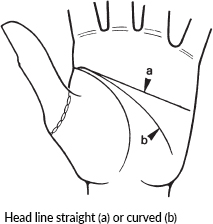
When the line is straight and short, we are looking at someone who is immersed in a particular subject—this is a real train-spotter type. He will bring it into any conversation at the drop of a hat. Another effect of a short head line is that the person cannot be bothered to think or analyze anything and simply plods through life without making any mental effort.
A line that slopes downward toward Luna shows a creative imagination. This subject can succeed in business because he can pool his practical, creative and imaginative skills and introduce a useful touch of intuition.
A straight line that suddenly dips downward at the end belongs to a person who loses his temper or can be extremely sarcastic.
A long head line signifies a person who never stops learning. If the line is straight, the person may confine his studies to his career while if it slopes or curves his tastes will be more diverse. If the line reaches the percussion the person will be involved with foreign people and places—possibly in connection with his work.
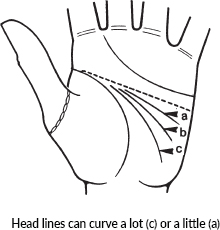
A curved or sloping head line that leans down toward Luna tells us that the subject has a powerful imagination. This can reveal itself in the way the person thinks, his educational and career choices or his intuition. He may be interested in travel and exploration or art and creativity. If the line is forked he will have a talent for writing and he will be versatile. If the line is long, the subject is discriminating and a perfectionist. Curved lines indicate creativity but also sensitivity, moodiness, and sometimes depression.
A head line that curves up or that throws a little line upward shows an improvement in the person's life, probably due to career or financial improvements. Downward bends and falling lines can indicate losses but they can also denote jobs or interests that the person discards.
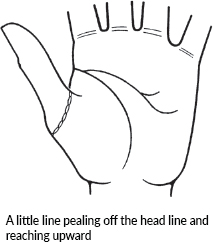
A truly double head line with two distinct starting and ending points is very rare. This person is unlikely to be quite sane. When the secondary line is faint, he may simply have a secondary interest, job or hobby.
Islands on the head line are a common feature. Chains of small islands that look like a skein of wool suggest that the subject suffers from headaches or migraines. An isolated island indicates a career or educational setback, a financial problem or unhappiness at work. Often this accompanies a feeling of being stuck in the wrong job, the wrong marriage or the wrong lifestyle. A triangle or diamond shaped island can mean actual imprisonment! A deep island that splits the head line into two for part of its journey and then re-joins it suggests severe mental illness.
A small island under the Saturn finger can indicate deafness; if the island is under the Apollo finger eye problems may be indicated.
A fork on the head line is known the writer's fork and it is said to show a talent for speech, acting and writing. Long forks also imply versatility and varied interests, two different part time jobs or a hobby or spare time activity that is different from the day job. Often this person has an ordinary job but is involved in something creative, expressive or artistic in his spare time. I have seen this on the hand of an accountant who was also a competition ballroom dancer and a homemaker who did something secret for MI6 in her spare time!
Breaks in the head line are common. They indicate a career break or even a period away from normal life due to sickness—especially if this affects anything in or around the head area. If there is a break with a square mark around it, the subject will recover completely.
Long lines that wander across the hand and cross the head line show interference in some aspect of the person's education, career or life. If these come from inside the life line, the family will cause the problem. Short bars indicate short, sharp setbacks.
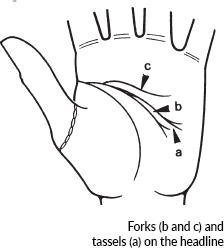
Too many forks, branches, tassels, islands, breaks and other disturbances are an indication of a troubled mind or a lifetime of struggle. If the head line is in pieces, the individual will be disorganized. A tassel ending is not a good omen as it indicates forgetfulness in later life.
The heart line shows how we feel about love and how we behave in connection with love and relationships. It would be nice if it showed the progress of the love life in detail but it only offers tantalizing glimpses.
The firmer the heart line the more straightforward the love life. It does not necessarily mean that the individual is any happier than someone whose love life is complicated but it does show a powerful sense of self-worth and a healthy ego—perhaps a bit too healthy at times! This person receives plenty of love and attention from parents, family, siblings, friends, and partner. He may not be as well-loved as he feels himself to be, but he thinks that others consider him wonderful. On the other hand, of course, he may just be a lovely person who is also extremely lucky in love.
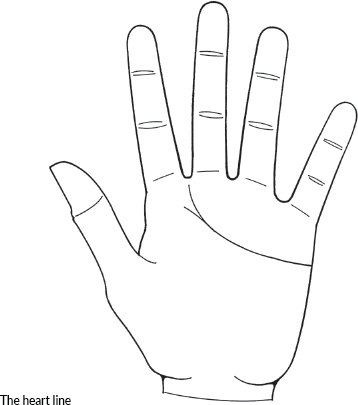
Young people often have very flaky or disturbed heart lines but these settle down later.
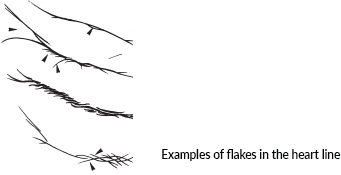
Some palmists consider that the heart line starts at the percussion edge of the hand while others see the end that is closer to thumb side as the starting point. I have always used the percussion end as the starting point, so that is how it will be in this book.
A long heart line shows a strong capacity for affection and friendship, while a short one shows an inward-looking nature with little capacity for love. This person can also be very demanding.
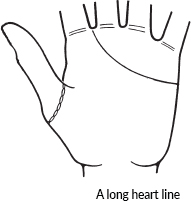
A curved heart line shows a capacity for affection. When a relationship breaks up, he will become very upset though he will soon get over it and move on to a new lover. He follows his heart and believes in romance and he will happily fall for someone from the wrong side of the tracks, another culture or financial bracket and so on. Practical considerations are less important to him than the meeting of mind, body, and soul.
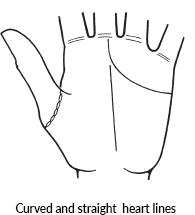
A person with a straight heart line selects a lover on the basis of the right education, who comes from the right background, or the right financial bracket. He might marry to climb the career ladder, get into the housing market, or for some other practical reason. The subject has a filter in his mind that automatically rejects an “unsuitable” person to be his wife or the mother of his children. This doesn't mean that he is entirely cynical or that he doesn't love his partner. Indeed, the filter might be subconscious and he may not be aware of it. When asked, all he will say is that he is choosy. The same person will happily throw away the rule book when it comes to a short-term affair.
Bear in mind that while I talk as if I am reading a man's hand in this book, everything applies to both sexes.
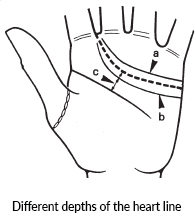
A shallow heart line (a) suggests less ability to love, or someone who wants to love but never quite manages to pull this off.
A deep heart line (b) that runs close to the head line can be a sign of intolerance. This person may be demanding, fussy, a perfectionist or full of rules and regulations. Sometimes severe family problems affect his outlook on life.
A fragmented line can make the subject more successful as a friend than as a partner. This also shows a wonderful sense of humor.
Breaks in the heart line symbolize relationships that end—or heartbreak. Islands usually indicate emotional trouble. Sometimes a clear island under the Apollo finger signifies that a relationship ended abruptly. In some cases, this is due to the sudden death of a partner; in other cases, the partner walks out without giving any warning.
A new piece of line often comes after a break, representing a new relationship. A new piece of line that reaches upward toward the fingers shows that the person will find love later in life. If a tiny double line reaches to the gap between the Jupiter and Saturn fingers, this is definitely the case.
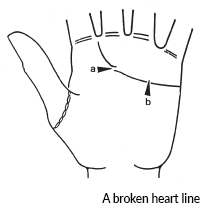
Don't forget that love is not only a matter of sexual relationships. It encompasses friendship and fondness for an animal—indeed, any form of affection.
Many people have light lines that fork and fall downward. These forks indicate friendships.
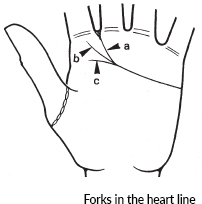
In my early days as a palmist, clients sometimes used to shove a hand out at me and tell me proudly that they had a so-called mystic cross on their palm which indicates psychic gifts. Some palmists say that it does mean this, but only when the cross doesn't touch any other line at all—and that would be extremely unusual. There are other indications of psychism on the hands though.
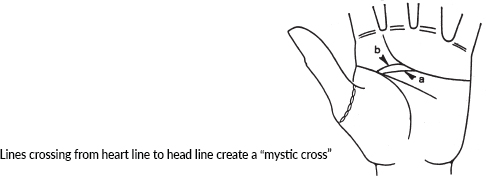
Islands on the heart line can indicate eye problems, dental, lung or breast problems and many other conditions. A serious disturbance on an otherwise clear line suggests that something is wrong. A spiky, tasseled or messy start to the heart line indicates problems with the myocardium or arteries (also check the nails and fingers to see if they have a blue, violet or grey tone). Blue pits on the line in the areas below and between Saturn and Mercury can indicate lung problems, while disturbances between Saturn and Jupiter denote breast problems.
Sometimes the head and heart lines merge into one strong line that cuts right across the hand forming a simian line. This can appear on one or both hands. The simian line is often heavy and chainlike. In many cases, there are semi-simian formations where there are vestigial pieces of head and heart line left on the hand.
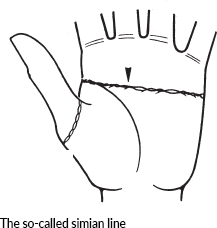
The word “simian,” meaning “monkey-like,” is used because early palmists thought that monkeys had this formation on their hands. I have visited zoos and studied the hands of many apes and monkeys, even going as far as taking handprints from a baby Barbary ape when I was in Gibraltar. I discovered that the lines on any monkey or ape hand are the same as human ones and that these creatures do not have a “simian” line formation. The skin ridge patterns are quite different from those of humans.
People with simian lines find it difficult to lead a normal, balanced life. They either focus entirely on their work or their relationship or something else in a one-sided manner. They hold onto resentments and then explode in a tantrum or floods of tears. These people can be very obstinate.
Semi-simian lines are also uncommon and they mean much the same as a simian line, but the person is likely to develop a more balanced attitude with time and experience.
If you learn nothing else about palmistry, try to come to grips with the fate line, because it has so much to tell. Not everybody has a fate line but if you look closely, you will often see fragments of it somewhere on the hand. The fate line runs vertically up the hand from the bottom to the top. It can start on Neptune (the middle of the base of the hand) or it can start nearer to one side or the other.
The fate line can be a partial line that starts and then fizzles out or one that does not start until higher up the hand. The fate line tells two stories, and it is hard to differentiate between them. The first story shows the times when we make an effort in life. The second story is about the amount of fate, destiny, kismet, karma and luck a person will experience—and when this will occur. It shows the benefits and challenges that we will have in relationships, finances, family, career and much else. This line can change quite a lot at times, so even bad things are not set in stone. Make an effort to improve your circumstances and your lines will change!
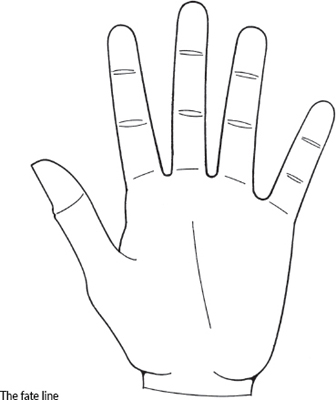
Note: This is sometimes called the Saturn line, because it is supposed to run toward the Saturn finger, but it can hive off toward the Jupiter or Apollo finger instead, so we will stick with the old name of fate line.
If there is no fate line, the person will not have to make much effort in life. A very strong, deeply marked line shows that the person will do what others tell him to. He may feel that he has a duty to his parents, job, spouse or family. However, this is not all bad news because he will make a success of whatever comes along. At least this fate line indicates that something happens in his life and he can be quite ambitious too.
This complicated illustration does not even cover all the possibilities.
Here are some quick clues to the meaning of the start of the line.
The line rises on Neptune—self-motivation and making one's own decisions early in life.
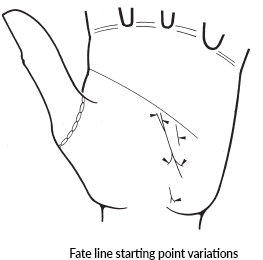
The line rises on the Venus side, from the life line or from within the life line. The family will help this person to get on in life—perhaps by paying for him to go to a good school or helping him to set up a home or a business. The person's family thinks well of him. The closer the line is to Venus, the more likely the individual will cling to his family when he becomes an adult. His family may dictate to him: he may like it that way or he may just put up with it.
The line rises from Luna. The subject will have help, acceptance, esteem and recognition from outsiders rather than from the family. The closer the starting point is to Luna, the more likely it is that he will strike out on his own early in life.
Sometimes the line only starts higher up on the hand. When the line starts at the head line, a lucky break may jump-start a career or tough circumstances will encourage this person to make an extra effort.
When the line starts at the heart line, it may be love that makes the difference. This also suggests that the subject's later years will be happier and more interesting than his early ones.
The fate line can fade out half way up the hand, which means that a period of effort ends. Partial fate lines can reappear further up the hand showing a change in fortunes. Here are a few more pointers:
The line runs toward Jupiter showing that the subject will put his heart into a career. If the fate line joins the heart line at the end, he may put his career before his love life.
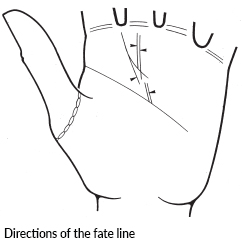
The fate line heads toward Saturn. The subject will always work hard and he may be very successful later in life.
The fate line ends between Saturn and Apollo. The subject will be happy later in life and able to spend money on luxuries and pleasures as well as necessities.
Here is a rough way of working out dates on the fate line; Take something like a piece of string and run it across the hand from the middle of the knuckle that lies at the base of the thumb.
Branches that join the fate line indicate friends, lovers, marriage partners, mentors in business, financial partners and many others who become part of his life for a while. The usual scenario is love or marriage.
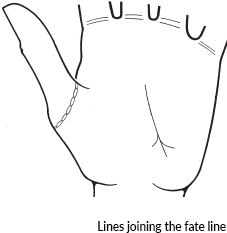
A relationship will start at the age of the join, but if it crosses over the line or runs with it for a while and then leaves, the relationship will not last.
A relationship will endure if a line joins the fate line and then becomes part of it.
A line joins the fate line from the thumb side of the hand. The lover will come from the same neighborhood and background as the subject. He and his family may know the lover for years before the couple gets together. Both lovers will have a similar culture, ambitions and outlook on life.
When the joining line comes in from the Luna side, the lover or person of influence comes from afar or from a different environment.
When a relationship breaks up, see if you can work out whether the lover goes back to mother (the joining line leaves on the Venus side) or goes away from the area (the joining line leaves on the Luna side).
Any disturbance to the fate line is interesting. Here are a few possibilities:
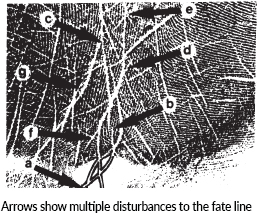
Bars, breaks, crosses, or any other kind of confusion on the line denotes setbacks. This can refer to career or financial setbacks, but health problems divorce or almost anything else could apply. These types of interference mean you have to look around the hand for more information.
Sometimes the fate line breaks and a new piece forms slightly higher up the hand. This may “jump” toward the radial or ulna side of the original line, and it might even run parallel to the original for part of its route. In which case, the individual will start something new while he is still in his previous situation. For example, he may start a business while still working at his job, or he may start a new relationship before leaving his previous one. If the new piece of line does not overlap, there will be a break between the past life and the new one.
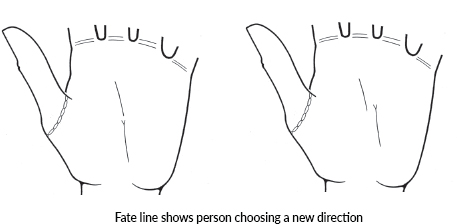
There will be less interest in work and more interest in home life if the new line jumps to the ulna side. The person may change his job to be closer to home or he may give up a demanding job for a lighter one—alternatively he may marry or decide to take more interest in the home and family. When the line jumps to the radial side, the subject becomes more interested in work and less interested in home life.
Sometimes the line breaks up into a number of little ones that resemble a small forest rather than a clear line. The person will become self-employed and thus have a great variety of tasks to cope with. He may put great bursts of energy into something at this point.
Sometimes the fate line comes to an abrupt end, leaving a gap before a new piece of line forms a little further up the hand. If the ending shows a small “Y” formation, the person will suddenly walk out of a job or project, leave a relationship, or even leave the country! This may appear to be a sudden impulse, but it has been coming for a long time. If a new section of line starts to rise up the hand— beside the bit that ends in the “Y”—the person will plan the break in advance, perhaps by looking for a new career direction before making the break.
Here are some of the many meanings attached to the end of the fate line.
